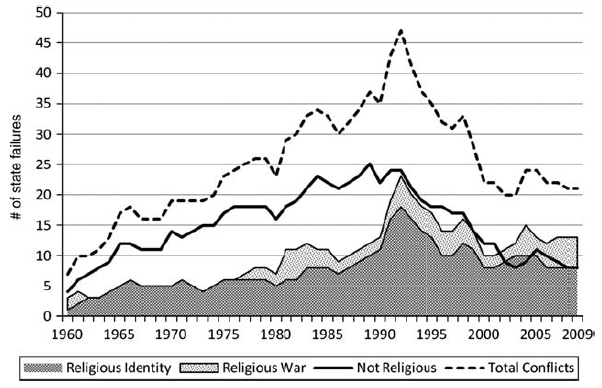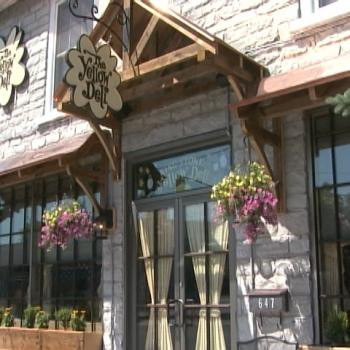Jonathan Fox, a Political Scientist at Bar-Ilan University in Ramat Gan, Israel, has reviewed data on conflicts worldwide since 1960, and found not only that there are currently more religious conflicts that there were in the 60s, but that religion now plays a role in over half of all conflicts.
By ‘religious conflict’ he doesn’t mean one that is just about religion – such conflicts are few and far between. Rather, he means one in which religion is a significant factor, meeting at least one of these criteria:
- It is between groups who belong to different religions;
- It is between groups that belong to different denominations of the same religions (e.g. Protestants vs. Catholics or Sunni Muslims vs. Shi’i Muslims)
- The issues in the conflict include (but are by no means limited to) significant religious issues, such as state religion policy or the role of religion in the regime. These issues need not be the most important issue in the conflict but they must be among the central issues in the conflict.
He used a standard and widely-used database of conflicts (the PITF), extracting data on ethnic wars, genocides and politicides and revolutionary wars, and categorised them according to whether they involved a conflict of religious identity conflict (the two groups involved in the conflict belong to different religions or different denominations of the same religion) or a religious war (both sides are the same religion, but religion is an issue in the conflict – usually fundamentalists versus secular states).
Overall, wars of all kinds peaked in the early 1990s and have dropped away since. The same trend is shown by religious wars, although the drop-off has not been so sharp.
The result is that religious wars are making up an increasingly large portion of the total – a trend that can be identified as starting in the late 1970s (think: Iranian Revolution).
These wars increasingly involve Islamic fighters. In recent years, 70% of all conflict and 100% of all religious wars have had an Islamic component.
However, they are not inter-religious wars. Conflicts involving Christians have declined somewhat, and other religions even more. This conflicts with the ‘Clash of Civilisations‘ idea, in which Samuel Huntingdon proposed that conflicts between the West and Islam would increase following the end of the Cold War.
What Fox thinks is happening is a combination of two factors.
Firstly, he cites David Rapoport’s Wave Theory of terrorist causes. This basically says that terrorist causes rise and fall roughly every 45 years. Each generation, looking for a cause to make its own, rejects the causes of the generation before and seeks out a new cause.
Islam, then, is simply the current vehicle for revolutionary idealism – following on in the footsteps of anarchism, anti-colonialism, and ‘new-left’ terrorism. Revolutionaries latch onto Islamism as it offers a stark contrast to the established, secular states.
In this reading, the current wave of Islamic conflict will ebb in turn, probably over the next 10-20 years. Maybe the ‘Arab Spring’ is the first flickerings of the next wave!
![]()
Jonathan Fox (2012). The Religious Wave: Religion and Domestic Conflict from 1960 to 2009 Civil Wars DOI: 10.1080/13698249.2012.679492
 This article by Tom Rees was first published on Epiphenom. It is licensed under Creative Commons.
This article by Tom Rees was first published on Epiphenom. It is licensed under Creative Commons.














